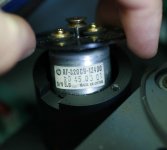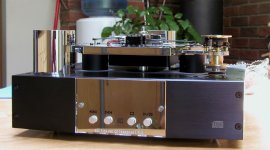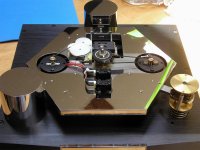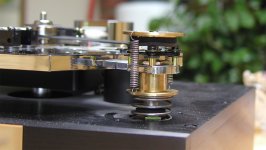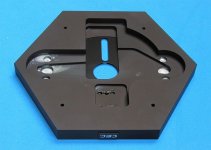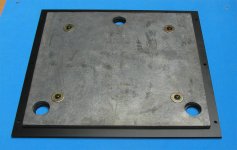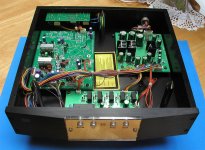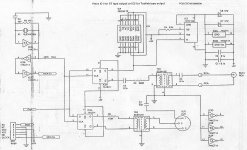FYI,
I have obtained and cobbled up 4 different transports in the last week. I have listened to all 4, played with PSU improvements and mucked about with a few decoupling tweaks just for fun. I am having trouble synchronizing my computer based data analyser to compare 90 second long SPDIF data streams from several transports. I have never really investigated the differences in data retrieval and error correction before, but then again I have never used transports I considered to be suspect.
In reference to the Mabuchi (and other clones) spindle motors; they are the most commonly replaced part in CD players (that and loading belts). We used to get bulk packs of 20 from Pioneer back in the day. It's not that the motor is badly designed, it is a simple sintered/plated plate brush motor being asked to do something it shouldn't- be PWM or PPM driven to precise speeds. It is a free running DC motor. The commutators and brushes quickly deteriorate, in fact, depending on the chipset driving them and the agression of the circuitry, they can die in a year or less. Bottom line is they deteriorate from day one. That is why a 'real' transport doesn't use them. Practically every first generation CD player used a slotless, coreless spindle motor, because they knew a)they are better and b)their servo circuitry was primitive and they needed all the help they could get.
All the Technics machines used them (a miniature version of a SL1200 motor almost)
Sony used them
Akai, Kyocera et al used them
The first Pioneers used them.
Philips used them and still do, except in the cheap mechanisms
All the 'expensive esoterica' used someone's transport with quality motors.
What changed? The servo circuitry got so good, you could put a kids toy motor in and it would work. That is what we are using in this situation.
The best transports used linear motors. Why? Because they don't wear out- at all, ever. No gear slack, no broken teeth, no dried up grease, noisy or failing motors.
The perfect relialbility and performance combinations were found when modern servo and control circuitry was used with quality drive mechanisms. That happened around 1987-1990 in Japan.
The Shiga xxxx is none of those things. Just because some 2nd rate outfit in Japan goes all 'Zen' or whatever and packs the cheapest mechanism it could find into a nicely milled block of metal and garners a few pointless reviews on a 'quality' sites like X moons doesn't mean we should go out and blindly copy it.
Don't get me wrong, these beautiful caseworks of engineering art made my true craftsmen and mechanical engineers I appreciate. The elctronic implementation however is very rough in all but a few.
Responsibility here is the key. People are spending real money on making something they 'believe' is going to be good- all with NO evidence. The Shiga original and Shiga clone haven't been actually tested against anything else. I have searched the net for test results and there isn't anything.
That is what I intend to do- test the thing, in fact several of them, and publish the results for all to see.
BTW, the best eye pattern (of the 4 Sanyo 101N lasers)so far came from one transport using the lightweight triple ball spring clamp- the clamp arrangement with a magnet is clearly inferior, extra mass on the motor of even a few extra grams causes a nasty wavering on the eye pattern.
I have obtained and cobbled up 4 different transports in the last week. I have listened to all 4, played with PSU improvements and mucked about with a few decoupling tweaks just for fun. I am having trouble synchronizing my computer based data analyser to compare 90 second long SPDIF data streams from several transports. I have never really investigated the differences in data retrieval and error correction before, but then again I have never used transports I considered to be suspect.
In reference to the Mabuchi (and other clones) spindle motors; they are the most commonly replaced part in CD players (that and loading belts). We used to get bulk packs of 20 from Pioneer back in the day. It's not that the motor is badly designed, it is a simple sintered/plated plate brush motor being asked to do something it shouldn't- be PWM or PPM driven to precise speeds. It is a free running DC motor. The commutators and brushes quickly deteriorate, in fact, depending on the chipset driving them and the agression of the circuitry, they can die in a year or less. Bottom line is they deteriorate from day one. That is why a 'real' transport doesn't use them. Practically every first generation CD player used a slotless, coreless spindle motor, because they knew a)they are better and b)their servo circuitry was primitive and they needed all the help they could get.
All the Technics machines used them (a miniature version of a SL1200 motor almost)
Sony used them
Akai, Kyocera et al used them
The first Pioneers used them.
Philips used them and still do, except in the cheap mechanisms
All the 'expensive esoterica' used someone's transport with quality motors.
What changed? The servo circuitry got so good, you could put a kids toy motor in and it would work. That is what we are using in this situation.
The best transports used linear motors. Why? Because they don't wear out- at all, ever. No gear slack, no broken teeth, no dried up grease, noisy or failing motors.
The perfect relialbility and performance combinations were found when modern servo and control circuitry was used with quality drive mechanisms. That happened around 1987-1990 in Japan.
The Shiga xxxx is none of those things. Just because some 2nd rate outfit in Japan goes all 'Zen' or whatever and packs the cheapest mechanism it could find into a nicely milled block of metal and garners a few pointless reviews on a 'quality' sites like X moons doesn't mean we should go out and blindly copy it.
Don't get me wrong, these beautiful caseworks of engineering art made my true craftsmen and mechanical engineers I appreciate. The elctronic implementation however is very rough in all but a few.
Responsibility here is the key. People are spending real money on making something they 'believe' is going to be good- all with NO evidence. The Shiga original and Shiga clone haven't been actually tested against anything else. I have searched the net for test results and there isn't anything.
That is what I intend to do- test the thing, in fact several of them, and publish the results for all to see.
BTW, the best eye pattern (of the 4 Sanyo 101N lasers)so far came from one transport using the lightweight triple ball spring clamp- the clamp arrangement with a magnet is clearly inferior, extra mass on the motor of even a few extra grams causes a nasty wavering on the eye pattern.
That is why a 'real' transport doesn't use them.
All the 'expensive esoterica' used someone's transport with quality motors.
Actually, one of the best regarded and 'expensive esoterica' trasport uses Mabuchi motors:
Attachments
BTW, the best eye pattern (of the 4 Sanyo 101N lasers)so far came from one transport using the lightweight triple ball spring clamp- the clamp arrangement with a magnet is clearly inferior, extra mass on the motor of even a few extra grams causes a nasty wavering on the eye pattern.
Care to actually share the name brand and cost of the unit using this transport?
The whole point to the Shigaclone for me is the option to build a very inexpensive transport in a custom enclosure to fit a custom application in an old console I'm refurbishing to more modern hardware. A $150 investment coupled with a $400 NOS DAC that sounds better than $1K-$5K CDPs and fits in my old console is a pretty neat feat, irregardless if it can be beaten in SQ by a >$10K CD transport. My application inherently limits the ultimate HiFi experience as it relates to pure SQ, but what I lose in SQ I gain in nostalgia, enjoyment, satisfaction from building it mself, and WAF.
Are any of the transports you have tested readily available and under US$250 or US$500? If so, post the models up and let us run with them.
We so often see guys running wild with test equipment, coming to conclusions what a piece of equipment sounds like being biased by measurements. Here's one such, recent, example: http://www.lampizator.eu/LAMPIZATOR/REFERENCES/CEC/CEC TL-1X.html
Anybody noticed what went wrong with this guy's testing procedure (output board schematic attached)?
Anybody noticed what went wrong with this guy's testing procedure (output board schematic attached)?
Attachments
Last edited:
Not to put too fine a point on it, but none of your comments are going to detract in any way from my enjoyment of the Shigaclone and I suspect that most people who have built one based on Peter's ideas will feel the same way.
me too
FYI,
I have obtained and cobbled up 4 different transports in the last week. I have listened to all 4, played with PSU improvements and mucked about with a few decoupling tweaks just for fun. I am having trouble synchronizing my computer based data analyser to compare 90 second long SPDIF data streams from several transports. I have never really investigated the differences in data retrieval and error correction before, but then again I have never used transports I considered to be suspect.
In reference to the Mabuchi (and other clones) spindle motors; they are the most commonly replaced part in CD players (that and loading belts). We used to get bulk packs of 20 from Pioneer back in the day. It's not that the motor is badly designed, it is a simple sintered/plated plate brush motor being asked to do something it shouldn't- be PWM or PPM driven to precise speeds. It is a free running DC motor. The commutators and brushes quickly deteriorate, in fact, depending on the chipset driving them and the agression of the circuitry, they can die in a year or less. Bottom line is they deteriorate from day one. That is why a 'real' transport doesn't use them. Practically every first generation CD player used a slotless, coreless spindle motor, because they knew a)they are better and b)their servo circuitry was primitive and they needed all the help they could get.
All the Technics machines used them (a miniature version of a SL1200 motor almost)
Sony used them
Akai, Kyocera et al used them
The first Pioneers used them.
Philips used them and still do, except in the cheap mechanisms
All the 'expensive esoterica' used someone's transport with quality motors.
What changed? The servo circuitry got so good, you could put a kids toy motor in and it would work. That is what we are using in this situation.
The best transports used linear motors. Why? Because they don't wear out- at all, ever. No gear slack, no broken teeth, no dried up grease, noisy or failing motors.
The perfect relialbility and performance combinations were found when modern servo and control circuitry was used with quality drive mechanisms. That happened around 1987-1990 in Japan.
The Shiga xxxx is none of those things. Just because some 2nd rate outfit in Japan goes all 'Zen' or whatever and packs the cheapest mechanism it could find into a nicely milled block of metal and garners a few pointless reviews on a 'quality' sites like X moons doesn't mean we should go out and blindly copy it.
Don't get me wrong, these beautiful caseworks of engineering art made my true craftsmen and mechanical engineers I appreciate. The elctronic implementation however is very rough in all but a few.
Responsibility here is the key. People are spending real money on making something they 'believe' is going to be good- all with NO evidence. The Shiga original and Shiga clone haven't been actually tested against anything else. I have searched the net for test results and there isn't anything.
That is what I intend to do- test the thing, in fact several of them, and publish the results for all to see.
BTW, the best eye pattern (of the 4 Sanyo 101N lasers)so far came from one transport using the lightweight triple ball spring clamp- the clamp arrangement with a magnet is clearly inferior, extra mass on the motor of even a few extra grams causes a nasty wavering on the eye pattern.
I'm all for scientific method and in fact live with it everyday, (I'm an EE currently in medical electronics) but so far I have not found a whole lot of really good scientific explanations for what I can hear. Ultimately while I agree that measurements are important, they don't necessarily always correlate with what you hear.
You can certainly measure the spdif stream quality of these mechanisms, and with the known error correction (I know it is not that robust) issues it is not going to be all that impressive.
Your comments about the effect of mass loading on the spindle motor I can well believe - in the end does it really matter as long as the data is recovered successfully? The data is sliced and reclocked before it is de-interleaved and the timing precision relates more to oscilator and internal timing structure of the dsp IC than anything else IMO. Not to mention the large number of CDs out there that are actually slightly eccentric as well.
Ultimately others have pointed out that there are no good, cheap alternatives. Good used transports are expensive and built generally on mechanisms that either are no longer available or soon won't be. This very cheap mechanism can be replaced with another very readily when it wears out.
Incidentally I use mine quite a lot and it has been running for over a year without problems - so it is more durable than I initially expected.
By your argument I nor anyone else should ever deign to design and build an amplifier or anything else that has not already been proven. I use custom and therefore unproven iron in a lot of my designs, and design stuff on paper, build it, cursorily measure parametric performance to see if it is close to what I expected (spice models or manual calculations, swags, etc.)
Like many here I started with a very minimal set of expectations and built a test bed on a wooden plank to experiment with the mechanism and electronics. It worked better than I expected and that motivated me to try to take it a bit further.
Perhaps a more positively received and equally useful approach would be to try and determine just what attributes this combination of hardware actually brings to the table and how that might impact what people are hearing? Try to explain why the mediocre specifications result in sound that many find appealing, myself included?
As an aside I purchased my second cd player in 1991 - A Sony CDP-791 (IIRC) which cost about $300 at the time, it had all dc motors and 18yrs 10K hours later it is still running fine. Heavily modified that machine gave me the first taste of reasonably high end performance. (My first machine which was a Philips that encompassed all of the engineering goodness you mention died a great many years ago, with far fewer hours of use.)
The Shigaclone with my Wolfson 8804 / 2 X PCM1794A / THS4131 based dac (loosely based on some boards purchased from TPA) completely blows it out of the water. Going out on a limb I believe that it also outperforms the PSA Lambda Drive/PSA Ultralink II combo I had for many years. (The dacs were compared, the transports were not.)
Your dismissal of 47 Labs could just as equally apply to any boutique vendor making audio gear; ARC, CJ, Cary Audio, PSA, Theta Digital, DCS, Marantz, etc., because like 47 Labs they all cater to those in the lunatic fringe who value sound quality above excellent measurements. (I'll admit some companies certainly have more resources to perform engineering investigation than others.)
Last edited:
We so often see guys running wild with test equipment, coming to conclusions what a piece of equipment sounds like being biased by measurements. Here's one such, recent, example: http://www.lampizator.eu/LAMPIZATOR/REFERENCES/CEC/CEC TL-1X.html
Anybody noticed what went wrong with this guy's testing procedure (output board schematic attached)?
Amongst other things he did not terminate the spdif signal into 75 ohms which would account for a lot of the nastiness he saw in that spdif signal.
1X scope probe may have mucho capacitance as well. The output gets its ground reference from the device it is driving which is fine in my experience. (I do that too.) SPDIF transformers don't behave too well when not properly terminated.
The other comments about the bass performance were priceless if clueless. Totally unrelated - the spdif stream is de-interleaved error corrected 16 bit pcm stereo digital data (except when HDCD is played when there are 4 additional subcode bits present.) There is very little LF content in spdif.
He does have a point about the spdif, aes/ebu interface board at least so far as the AES end of things is concerned, and that is using both Q and /Q outputs of the reclocking FF the transitions aren't absolutely guaranteed to line up (causing glitches in the transition region of the waveform) - better to drive that transformer single ended and use a transformer ratio that gives you the proper output voltage for AES. (fairly large range of voltage values are acceptable - too lazy to look it up.) It's actually considered to be very poor design practice, but Theta and PSA both did it in various transport designs from around the same time frame.
Last edited:
I also have to disagree with the TECHNICAL report which is more or less an advise ...saying " no go with the ShigaClone ".
I think that it is discouraging to a lot of people......depriving them of a very nice experience to say the least!!!!
The best mails to my humble belief are the mails of people who have build it and listened to it...in the proces.
I must say that I did study this project together with Scrutinizer to the extreme...day after day...night after night...
We tried nearly everything to make it perform better not even paying attention to the costs...and it kept turning out rewarding....mod after mod!!!
My conclusion it is a GEM.....and people should go ahead AND POST their enthousiasm or disappointments .
For me personally it means playing 3-4 hours a day with this machine for a year or so...proving that it holds its own...
Do not think that top machines always use top parts...the mabuchi motor is e.g. EXACTLY the same as in my Wadia transport which performed 15 Years for 3-4 hours a day.....so here you have a 2 dollar motor in a 3000 dollar machine...but what the hell...it worked and played beautiful music over the years.....cudos to Wadia.
Furthermore I'd like to think of myself as being very objective (I reckon Peter as well) since we both have "high-end stuff" to compare instantly with our "cheap" hobby-contraptions.....and the winner stays...for me it is as simple as that....what audio-component is capable of bringing magic in the room.........f*ck the make and the price-range or the commercials or the status
....so bring in the Shiga and make it happen....
I think that it is discouraging to a lot of people......depriving them of a very nice experience to say the least!!!!
The best mails to my humble belief are the mails of people who have build it and listened to it...in the proces.
I must say that I did study this project together with Scrutinizer to the extreme...day after day...night after night...
We tried nearly everything to make it perform better not even paying attention to the costs...and it kept turning out rewarding....mod after mod!!!
My conclusion it is a GEM.....and people should go ahead AND POST their enthousiasm or disappointments .
For me personally it means playing 3-4 hours a day with this machine for a year or so...proving that it holds its own...
Do not think that top machines always use top parts...the mabuchi motor is e.g. EXACTLY the same as in my Wadia transport which performed 15 Years for 3-4 hours a day.....so here you have a 2 dollar motor in a 3000 dollar machine...but what the hell...it worked and played beautiful music over the years.....cudos to Wadia.
Furthermore I'd like to think of myself as being very objective (I reckon Peter as well) since we both have "high-end stuff" to compare instantly with our "cheap" hobby-contraptions.....and the winner stays...for me it is as simple as that....what audio-component is capable of bringing magic in the room.........f*ck the make and the price-range or the commercials or the status
....so bring in the Shiga and make it happen....
Hi all, after reading about Daniel's discovery a couple of years back and seeing that this thread is alive and well after years of information sharing I would like to tackle this project. My question is, are the JVC boomboxes offered today still the right ones? or where can I purchase my deconstruction boombox and be sure I am not making a mistake? Thanks.
I will post some mechanism, board and chipset options for you.
I have been hunting around looking for current boomboxes that use the same chipset and so far, I have only found one in Australia.
It is is fun project and one I definitely recommend.
The Sanyo laser is history ever since Sanyo offloaded the optical division, however there are numerous clones that all do the same job (pics to follow)
The chipset is also discontinued although chinese manufacturers still have massive stockholdings going into boomboxes, the trick is finding them.
Pics and instructions to follow tonight.
I have been hunting around looking for current boomboxes that use the same chipset and so far, I have only found one in Australia.
It is is fun project and one I definitely recommend.
The Sanyo laser is history ever since Sanyo offloaded the optical division, however there are numerous clones that all do the same job (pics to follow)
The chipset is also discontinued although chinese manufacturers still have massive stockholdings going into boomboxes, the trick is finding them.
Pics and instructions to follow tonight.
Well, the actual ones that were originally spec;d were the RC-EZ31 and RC-EZ51. One person got the RC-EZ32 to run, but it wasn't easy.
Search for those first. There may be some on ebay. Buy 2 and then you have a spare controller board if you mess it up on soldering. The replacement mechanisms are cheapo on ebay.
Fran
Search for those first. There may be some on ebay. Buy 2 and then you have a spare controller board if you mess it up on soldering. The replacement mechanisms are cheapo on ebay.
Fran
Hi all, after reading about Daniel's discovery a couple of years back and seeing that this thread is alive and well after years of information sharing I would like to tackle this project. My question is, are the JVC boomboxes offered today still the right ones? or where can I purchase my deconstruction boombox and be sure I am not making a mistake? Thanks.
I purchased a spare unit that I'm willing to sell if you're interested.
Regards,
Dan
Unfortunately Zellers online arm does not sell into the United States as I discovered to my chagrin when I first started working on my clone.
I'm the one incidentally who built one with the RC-EZ32 - still works just fine. Was not that easy to get it working, but the details still exist in the early part of this thread if you happen to find one of these.
I'm the one incidentally who built one with the RC-EZ32 - still works just fine. Was not that easy to get it working, but the details still exist in the early part of this thread if you happen to find one of these.
I will post some mechanism, board and chipset options for you.
I have been hunting around looking for current boomboxes that use the same chipset and so far, I have only found one in Australia.
It is is fun project and one I definitely recommend.
The Sanyo laser is history ever since Sanyo offloaded the optical division, however there are numerous clones that all do the same job (pics to follow)
The chipset is also discontinued although chinese manufacturers still have massive stockholdings going into boomboxes, the trick is finding them.
Pics and instructions to follow tonight.
I'd be interested in sources for the chip set if you happen to know of them.
I started a list of units that use, or might use, the right drive/laser
AIWA
CSD-A510 519
CCD-A1270 110 100 99
CSD-TD20 21- TD24 26 27 28- TD31
CSD-TD41 42 -TD51 52 53 -TD63 61
SF-P101-NR LA9241 LA6541 LC78622
CSD-FD71 73
DA11T3C SF-P101-NR
XR-M200 201
CD MECHANISM: 3ZG-3 E3NC (?)
LA9241 LC78622 TC2092
Denon UD-M31
DA11T3CN LC9241 LA6559 LC78625
JVC RC-EZ31
LC9241 LA6541 LC78601
Sanyo
DC-DA170
SF-P101N LA9241 LA6541 LC78622
DC-MCR60
DT11T3CN LA9242 LC78629 MM1469
DC-MS1
SF-P1PS
LC9210 BA6296 LC7861 TDA1311
DC-X8CT
DA11N-SASH
LA9241 LA6541 LC78622
Philips
MCD-Z90F
LA9250 LA6541 LC78602
MCD-Z100F
CD94V5 LA9240 LA6541 LC78622
MCD-ZX600F
DA11T3CN LA9242M LA6541 LC78629E
MDC-Z128 130 CWM-240
DA11(?) LA9250M MM1469XH LC78602
MC-200
DA11 (15-pin) TDA7073 Focus
SAA7325H LM358 Laser pwr control
TDA1308 DAC
Sharp QT-CD110H
LA9241 LC78623 BA5914
Hope this helps
Regards
James
AIWA
CSD-A510 519
CCD-A1270 110 100 99
CSD-TD20 21- TD24 26 27 28- TD31
CSD-TD41 42 -TD51 52 53 -TD63 61
SF-P101-NR LA9241 LA6541 LC78622
CSD-FD71 73
DA11T3C SF-P101-NR
XR-M200 201
CD MECHANISM: 3ZG-3 E3NC (?)
LA9241 LC78622 TC2092
Denon UD-M31
DA11T3CN LC9241 LA6559 LC78625
JVC RC-EZ31
LC9241 LA6541 LC78601
Sanyo
DC-DA170
SF-P101N LA9241 LA6541 LC78622
DC-MCR60
DT11T3CN LA9242 LC78629 MM1469
DC-MS1
SF-P1PS
LC9210 BA6296 LC7861 TDA1311
DC-X8CT
DA11N-SASH
LA9241 LA6541 LC78622
Philips
MCD-Z90F
LA9250 LA6541 LC78602
MCD-Z100F
CD94V5 LA9240 LA6541 LC78622
MCD-ZX600F
DA11T3CN LA9242M LA6541 LC78629E
MDC-Z128 130 CWM-240
DA11(?) LA9250M MM1469XH LC78602
MC-200
DA11 (15-pin) TDA7073 Focus
SAA7325H LM358 Laser pwr control
TDA1308 DAC
Sharp QT-CD110H
LA9241 LC78623 BA5914
Hope this helps
Regards
James
- Home
- Source & Line
- Digital Source
- Finally, an affordable CD Transport: the Shigaclone story
